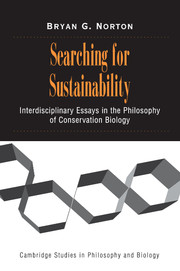Book contents
- Frontmatter
- Contents
- Searching for Sustainability
- General Introduction: An Interdisciplinary Experiment
- I PRAGMATISM AS AN ENVIRONMENTAL PHILOSOPHY
- II SCIENCE, POLICY, AND POLICY SCIENCE
- III ECONOMICS AND ENVIRONMENTAL SUSTAINABILITY
- IV SCALING SUSTAINABILITY: ECOLOGY AS IF HUMANS MATTERED
- 15 Context and Hierarchy in Aldo Leopold's Theory of Environmental Management
- 16 Scale and Biodiversity Policy: A Hierarchical Approach, with Robert E. Ulanowicz
- 17 Ecological Integrity and Social Values: At What Scale?
- 18 Change, Constancy, and Creativity: The New Ecology and Some Old Problems
- 19 Democracy and Sense of Place Values in Environmental Policy, with Bruce Hannon
- V SOME ELEMENTS OF A PHILOSOPHY OF SUSTAINABLE LIVING
- VI VALUING SUSTAINABILITY: TOWARD A MORE COMPREHENSIVE APPROACH TO ENVIRONMENTAL EVALUATION
- Index
- References
15 - Context and Hierarchy in Aldo Leopold's Theory of Environmental Management
Published online by Cambridge University Press: 21 January 2010
- Frontmatter
- Contents
- Searching for Sustainability
- General Introduction: An Interdisciplinary Experiment
- I PRAGMATISM AS AN ENVIRONMENTAL PHILOSOPHY
- II SCIENCE, POLICY, AND POLICY SCIENCE
- III ECONOMICS AND ENVIRONMENTAL SUSTAINABILITY
- IV SCALING SUSTAINABILITY: ECOLOGY AS IF HUMANS MATTERED
- 15 Context and Hierarchy in Aldo Leopold's Theory of Environmental Management
- 16 Scale and Biodiversity Policy: A Hierarchical Approach, with Robert E. Ulanowicz
- 17 Ecological Integrity and Social Values: At What Scale?
- 18 Change, Constancy, and Creativity: The New Ecology and Some Old Problems
- 19 Democracy and Sense of Place Values in Environmental Policy, with Bruce Hannon
- V SOME ELEMENTS OF A PHILOSOPHY OF SUSTAINABLE LIVING
- VI VALUING SUSTAINABILITY: TOWARD A MORE COMPREHENSIVE APPROACH TO ENVIRONMENTAL EVALUATION
- Index
- References
Summary
Perhaps the most pervasive trend in environmental management today is a movement toward holism. As one example. I quote from a U.S. Environmental Protection Agency document on the protection of Chesapeake Bay: “The Bay is, in many ways, like an incredibly complex living organism. Each of its parts is related to its other parts in a web of dependencies and support systems. For us to manage the Bay well, we must first understand how it functions” (USEPA. 1982).
The problem, historically, has been to develop a system of scientific concepts adequate to express holistic concerns while avoiding the introduction of metaphysical and speculative ideas such as a belief in a supraorganismic being corresponding to the biosphere-as-a-whole. Aldo Leopold, working in the field of wildlife and range management, recognized the importance of complexity and wholeness but felt uneasy attributing literal truth to the organicist metaphor (paper 1, this volume).
The purpose of this paper is to show that Leopold developed a theory of environmental management, to be distinguished from resource management. Resource management, which operates on a generally utilitarian criterion, deals with productive subsystems of larger functioning systems; rapid trends in land and resource use may force the environmental manager to pay attention to the larger context of those subsystems. Leopold significantly anticipated important insights of hierarchy theory, a new approach to understanding complexity in ecological systems.
- Type
- Chapter
- Information
- Searching for SustainabilityInterdisciplinary Essays in the Philosophy of Conservation Biology, pp. 280 - 287Publisher: Cambridge University PressPrint publication year: 2002



